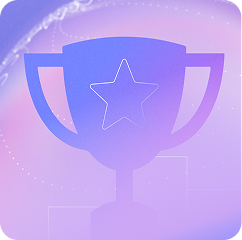
// Recruitment Technology, Software Comparisons
Want to win more clients? Choose an AI Note Taker that does more than take notes!
15/10/2024
15 MIN
Which AI notetaker is best?
We invited nine notetakers to a classic interview to see how they’d perform under the exact same conditions.
Why should you read this very long article? Because AI note-takers are one of the best use cases of AI in the world today. So many are turning to an AI note taker to make it easier to focus on the conversation and quickly find the details you need later.
Just recently, a quick poll by Jordan Vickery (an accounting consultant) showed that even outside of recruiting, 61% of people have already adopted notetakers)

But with so many options out there, how do you figure out which AI note taker is right for your business?
This detailed article cuts through the noise to compare the top nine note taking tools in the market. We’ve explored everything from transcription quality to AI powered summarisation, smart assistant features, and UX/UI design.
Key Snippets – How Do Note Takers Measure Up on Transcripts, AI Assistants, and UI?
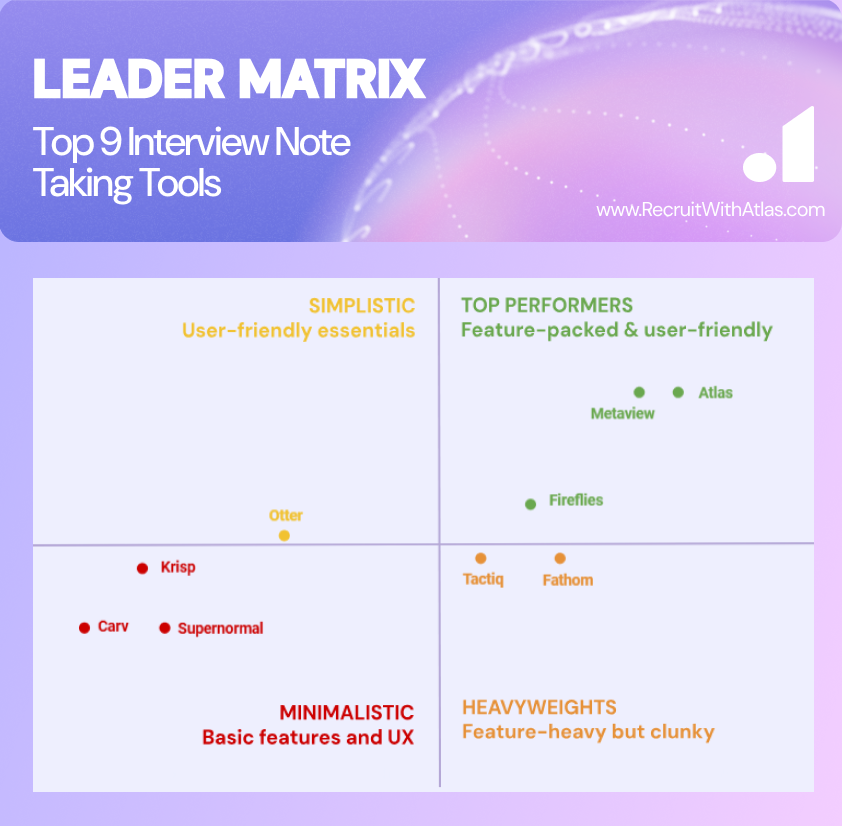
Do you find it annoying to have a CRM and a note-taker as two separate tools?
Would you prefer if your note-taker was natively inside your CRM?
If so, we have the solution for you!
See it in action!
Which note taker delivers the best transcription quality?

Rating Scales
5 – Perfect – Flawless accuracy and exceptional quality, with comprehensive and complete coverage.
4 – Great – Highly accurate with minor errors; excellent quality and mostly complete.
3 – Good – Generally accurate but with some errors; satisfactory quality and somewhat complete.
2 – Average – Several errors affecting accuracy; average quality and incomplete with missing details.
1 – Not So Good – Frequent inaccuracies; poor quality and significantly incomplete.
- Atlas stands out as the top choice. It offers karaoke-style transcripts and automatic speaker identification for accurate and convenient note-taking, helping you stay informed and make better decisions.
- Another great choice is Metaview, which provides reliable accuracy and handy TLDR summaries. These features let you quickly catch key highlights, helping you stay focused on engaging with candidates and clients.
- If you’re looking for interactive features, Tactiq is a good option since it lets you highlight and add callouts in your notes. However, it struggles with speaker identification and lacks recording links, which can lead to confusion.
- On the other hand, Fireflies delivers reliable and accurate transcriptions, ensuring essential details from meetings are captured.
- Carv offers complete but inaccurate transcripts with no timestamps or downloads. It links to videos for context but isn’t ideal if you need the text readily available.
- Fathom has great features for custom summaries and editing, but it can mix up speakers in more complex discussions, so you’ll want to double-check the accuracy before fully relying on its notes.
- Then there’s Krisp, which has average transcription accuracy but stands out with its custom vocabulary tool – perfect for industries that use unique jargon.
- Supernormal creates average-quality transcripts with timestamps, but its lack of links to recordings can make referencing a bit tricky and slow down your follow-ups.
- If you need precision, Otter may not be your best bet since its quality and accuracy are lower. However, it does come with timestamps and links directly to the conversation.
Which AI assistant simplifies your note taking process?
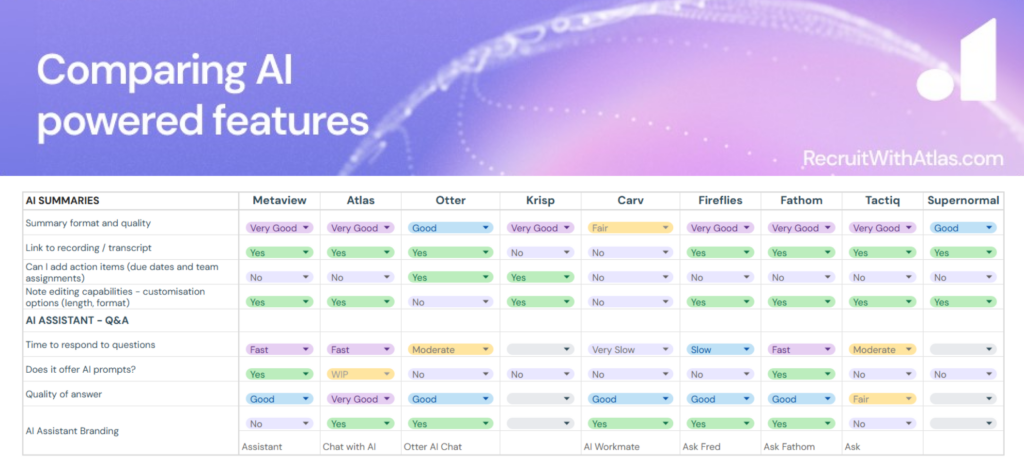
Rating Scales
5 – Excellent – Thorough, well-structured, highly concise, and focused entirely on the most relevant points.
4 – Very Good – Well-organised, mostly concise, and focuses on the main points with minimal irrelevant details.
3 – Good – Addresses most key points with moderate detail and clarity, but could be more focused.
2 – Fair – Covers some key points but lacks depth, has some structure, and includes not so relevant details.
1 – Inadequate– Disorganised, verbose, confusing, and misses key points.
1 – Extremely fast – 1 to 2 seconds
2- Fast – 2 to 4 seconds
3 – Moderate – 4 to 6 seconds
4 – Slow – 6 to 8 seconds
5 – Very slow – More than 8 seconds
- When it comes to AI assistants, Metaview is ideal for quick summaries and offers some nice customisation options. If you want detailed summaries with links to specific parts of recordings, Fathom has you sorted.
- And if you want quick, organised responses that give you actionable insights in seconds, Atlas delivers.
- Then there’s Fireflies, which offers concise summaries and filtering options, but you’ll need the Pro plan to access these features.
- If you have specific formatting needs, Tactiq is useful, but it lacks depth in its responses.
- Otter offers organised answers with transcript links and AI prompts, while Supernormal and Krisp provide basic features without interactive AI capabilities.
- And if you’re after simple summaries, Carv has you covered, although it comes with limited customisation.
What’s the easiest AI note taker to use?

Rating Scales
5 – Excellent – Intuitive navigation, visually appealing design, customisable, and easy to use without confusion.
4 – Very Good – Mostly smooth and user-friendly with minor improvements needed.
3 – Good – Simple navigation but with occasional challenges, design is decent but lacks strong customization options.
2 – Fair – Noticeable difficulties in navigation, requiring effort to find features and design lacks strong customization options.
1 – Poor – Confusing and difficult to use with few or no customization options, making it hard to locate anything.
- When it comes to user-friendly interfaces, Atlas and Metaview stand out. Both tools have modern, user-friendly interfaces that make them easy to navigate, even if you’re just starting out with note taking tools.
- Fireflies has a straightforward setup, though the navigation can be a bit confusing with screen overlays. And Fathom might feel a little cramped because of its limited customisation options.
- Tactiq is user-friendly too, but with all its features, it can be a bit overwhelming at first.
- Otter may have a distracting main page overlay, but once you get into your recordings, it gets easier.
- If simplicity is what you’re after, Carv, Krisp, and Supernormal all have straightforward designs that make them easy to use.
A Deep Dive into 9 AI Note Taker Tools for Recruitment Agencies
Let’s get into the specifics of these note taking tools so you can see which one fits your business best. Each option has its own strengths, and by understanding what they offer, you’ll be all set to choose the perfect note taker for your recruitment needs.
Transcription Quality and Accuracy
Why accurate and complete transcriptions are non-negotiable
Transcription quality and accuracy are important for you because they shape the insights and actions you get from recorded conversations.
The devil’s in the details. In recruitment, one word can change everything. If your transcripts are inaccurate, it can lead to misinterpretation and poor decisions. It’s about having reliable notes, not just notes.
Your AI assistant depends on this data, so having precise transcripts ensures it provides useful, contextually relevant answers, making analysis more effective for you.
Transcriptions compared – which note taker wins?
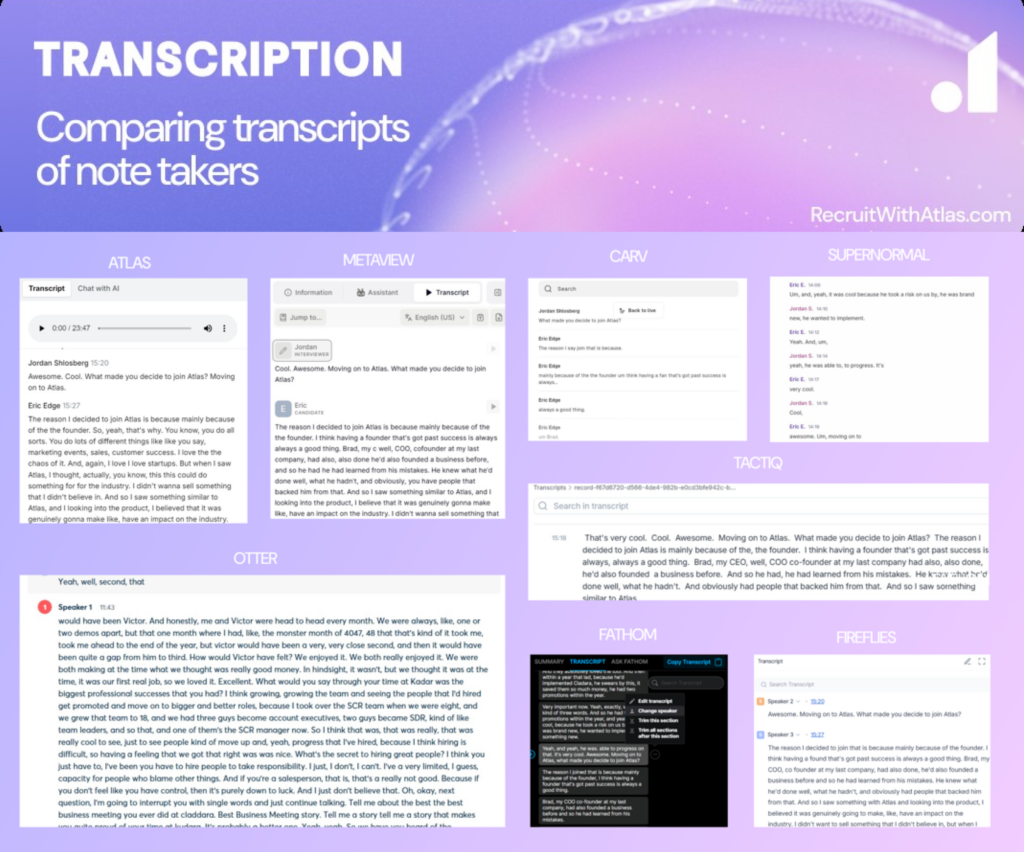
If you need accurate transcripts and the convenience of downloading both the recording and the text, Atlas is an ideal choice.
With its karaoke-style transcripts, you can jump straight to key moments in the conversation without wasting time.
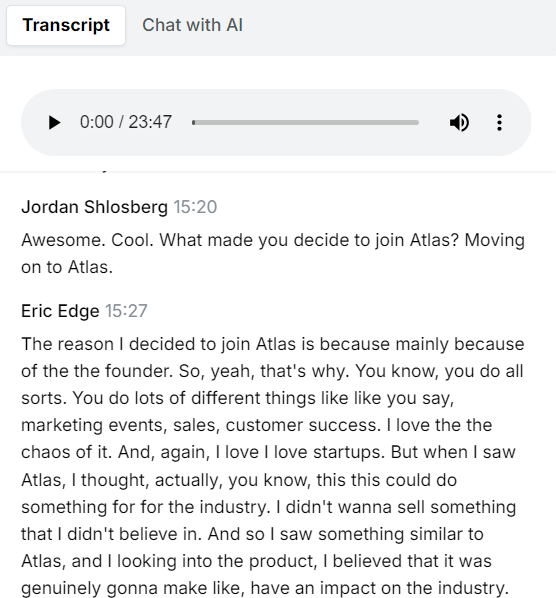
Metaview offers reasonably accurate transcripts, though it lacks timestamps. Instead, it offers links to specific sections in the recording, making it easy to navigate to relevant parts.
For those moments when you need a quick overview, the TLDR summarisation feature is a handy tool, giving you the gist of the conversation without the need to sift through the entire transcript.
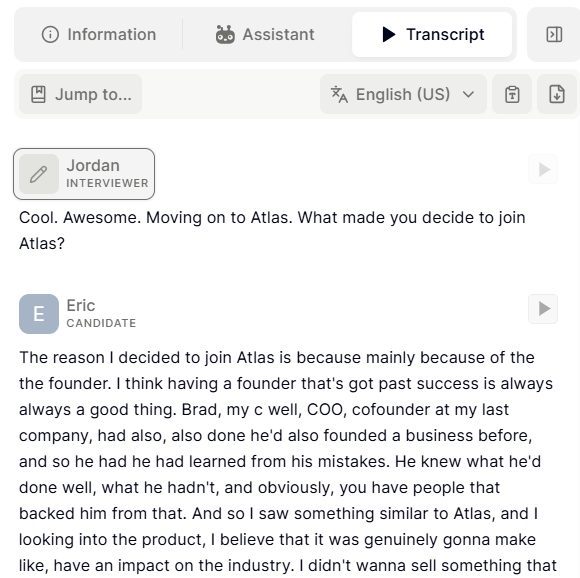
If you’re after more interactive features, Tactiq could be your tool. It gives you complete transcripts and lets you highlight, add questions, and make callouts. However, it occasionally mixes up speakers and isn’t linked to the recording, which can make following the conversation harder.
Then there’s Krisp, which offers average transcription accuracy but stands out with a custom vocabulary tool – perfect for industries with unique jargon. This helps to make the transcripts more accurate.
Supernormal generates average quality transcripts which includes timestamps and allows you to copy and download. But it is not linked to the recording, making it difficult for referencing things.
Carv gives you complete transcripts but are not accurate. It does not have timestamps and no download options.
Instead, it links the transcript to the video, which is useful if you need context from the original conversation, but not ideal if you prefer having the text on hand.
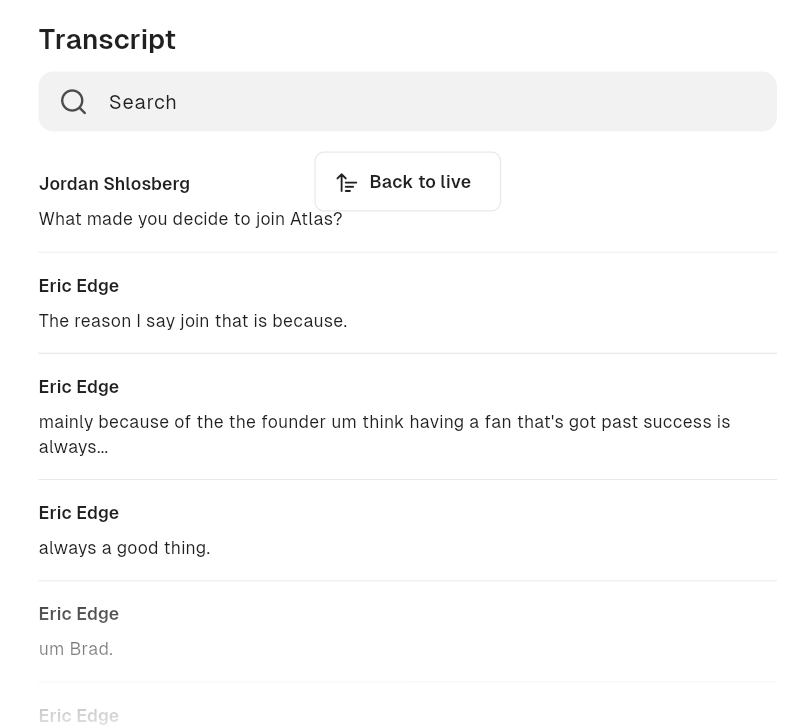
Fathom does provide fairly accurate and complete transcripts and it lets you copy, share, and download them, but sometimes it mixes up speakers and does not have timestamps.
You can manually change the speakers but that’s just another step in your hiring process.
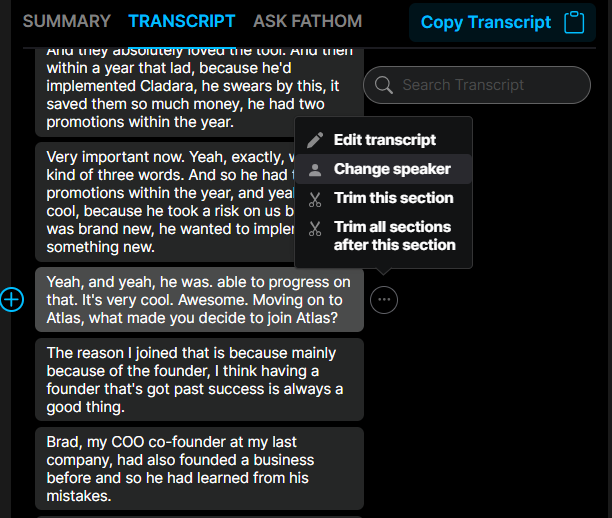
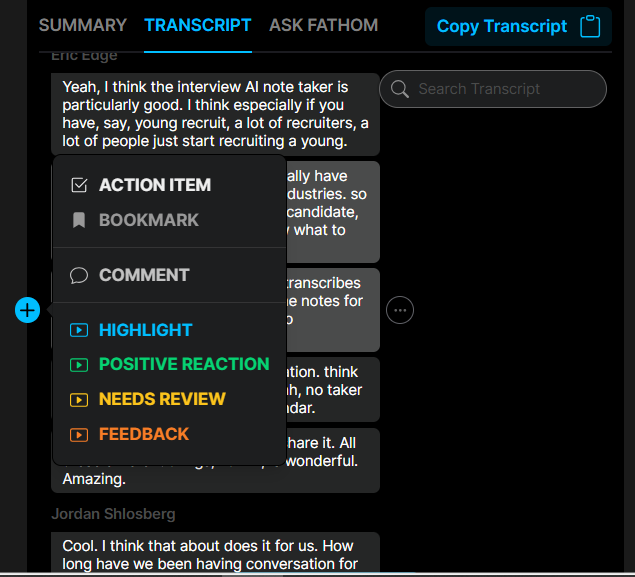
You can also mark up the transcript in Fathom with action items and comments making it versatile for anyone who needs to dig deep into their transcripts.
Then there’s Fireflies, which also gives you accurate and complete transcripts with timestamps.
It lets you copy and download, and does support importing recordings and transcripts.
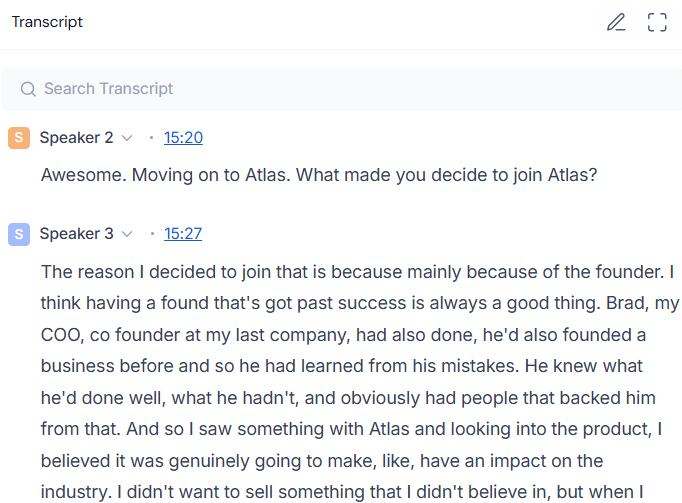
Finally, Otter.ai is less reliable when it comes to the quality and accuracy of transcripts.
It has timestamps, is linked to the conversation, and supports importing recordings, but it is not a great choice if you’re looking for more precise documentation.
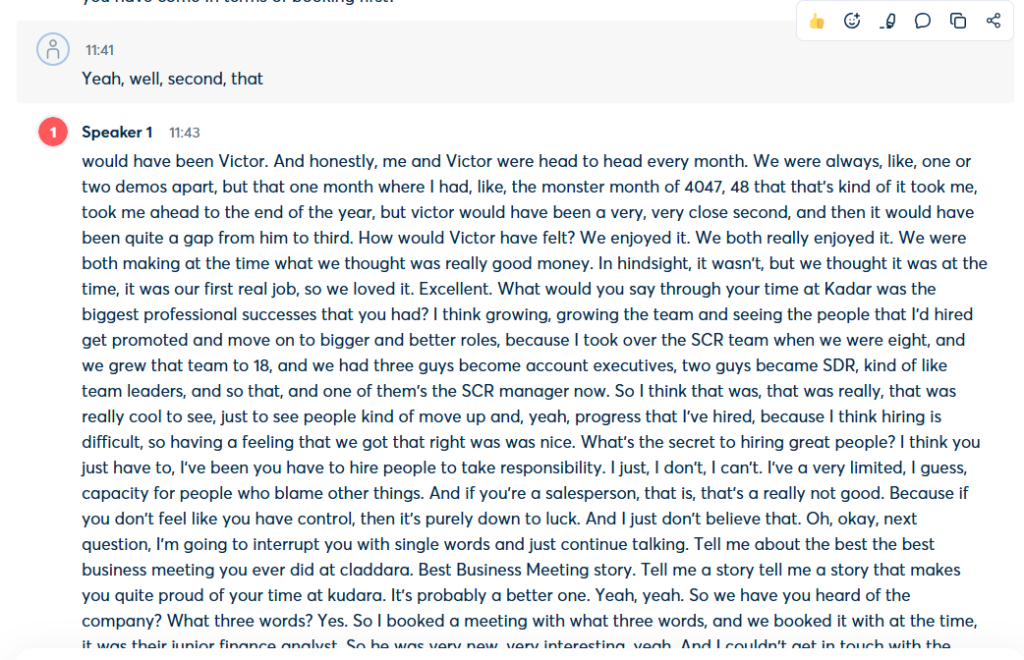
Do all tools identify speakers automatically?
No, not all note taking tools identify speakers, but this feature is important in conversations with multiple people, like interviews or meetings. Tagging speakers helps recruiters and managers follow the discussion and avoid mix-ups.
This is particularly important during candidate evaluations, where knowing exactly who posed questions or provided answers can prevent confusion and lead to better decisions.
It also simplifies reviewing and sharing transcripts, making key points easier to find and adding context for clearer follow-ups.
Comparing auto-tagging features across tools
When it comes to identifying and tagging speakers in your transcripts, the experience varies quite a bit across different tools.
Atlas automatically tagging speakers, which is incredibly useful when you’re sharing recordings with others. This feature is also a strength for Metaview, Carv, Supernormal, Fireflies, and Fathom, all of which make it easy to pinpoint who said what without any extra effort on your part.
On the flip side, tools like Otter and Tactiq fall short here. They don’t identify speakers by name, which can make it challenging to follow conversations, especially in larger meetings or discussions.
Krisp requires a bit more manual effort – you’ll need to assign speakers yourself, adding another step to your process.
Ultimately, which tool generates the best transcription?
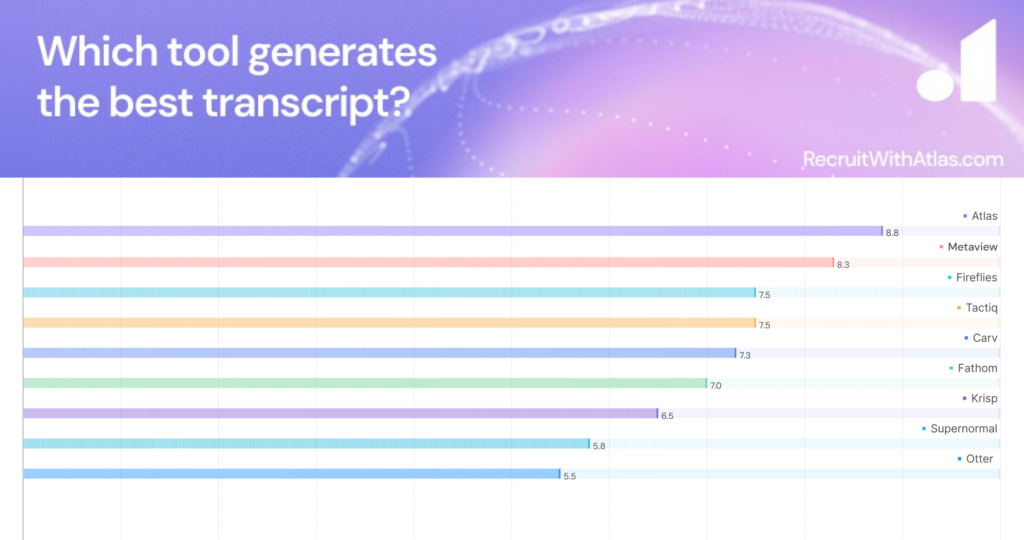
If accuracy and convenience are your priorities, Atlas is the clear winner, with karaoke-style transcripts and automatic speaker identification making it easy to navigate conversations.
Metaview also stands out for solid accuracy and TLDR summaries, which are perfect when you need to skim through transcripts.
For interactive features like highlighting and callouts, Tactiq is a good choice, though it struggles with identifying speakers and doesn’t link to recordings.
Another reliable option is Fireflies which offers good quality and accurate transcriptions. Carv, on the other hand, is useful if you need video context alongside your transcripts, but its accuracy isn’t the best.
Fathom has some useful features like generating custom summaries and transcript editing options, but occasional speaker mix-ups can cause confusion in complex conversations, making it less dependable for precise records.
If you’re recruiting in a sector with a lot of industry-specific jargon, Krisp stands out with its custom vocabulary feature. You can add the specific terms you use, which helps improve transcription accuracy. Just keep in mind that you’ll need to manually assign speakers, so it involves a bit more effort.
While Otter is user-friendly it lags behind in accuracy and reliability, making it less ideal for those needing precise documentation. And Supernormal delivers average transcripts without linking to recordings, leaving room for improvement.
AI Powered Features Comparison
AI summarisation in note taking tools is really helpful because it turns long conversations or meetings into short, actionable insights – saving you time.
By customising summaries, filtering them, and adding action items you adjust them to match your needs. This way you get the most important info right away, making it easier to follow up and keep everything organised.
An AI assistant with custom Q&A features in your note taking tool is essential because it adapts to your specific needs. It lets you set up custom questions and answers relevant to your industry, making responses more accurate and tailored to your tasks.
This automation saves you time by handling routine questions, letting you quickly find important info and keep things organised without any extra hassle. It also helps the AI get familiar with the specific terms you use.
When you’re choosing an AI assistant for note taking and summarisation, there are a few key things to think about, and each tool handles these things differently. Here’s a simple breakdown of what you might find:
Comparing AI Summaries and Notes
If you care a lot about how well the summaries are formatted and their quality, you’ll notice a big difference between the options out there.
Atlas is a great choice if you prefer structured summaries that break down your interviews into actionable sections. It’s perfect for easily extracting and reviewing key insights.
You can add Atlas to your next intake meeting or interview, and let it handle all the note taking for you .
You can even customize the note templates to look exactly the way you want. Every note Atlas generates is searchable anywhere on the platform, so finding the details you need is easy.
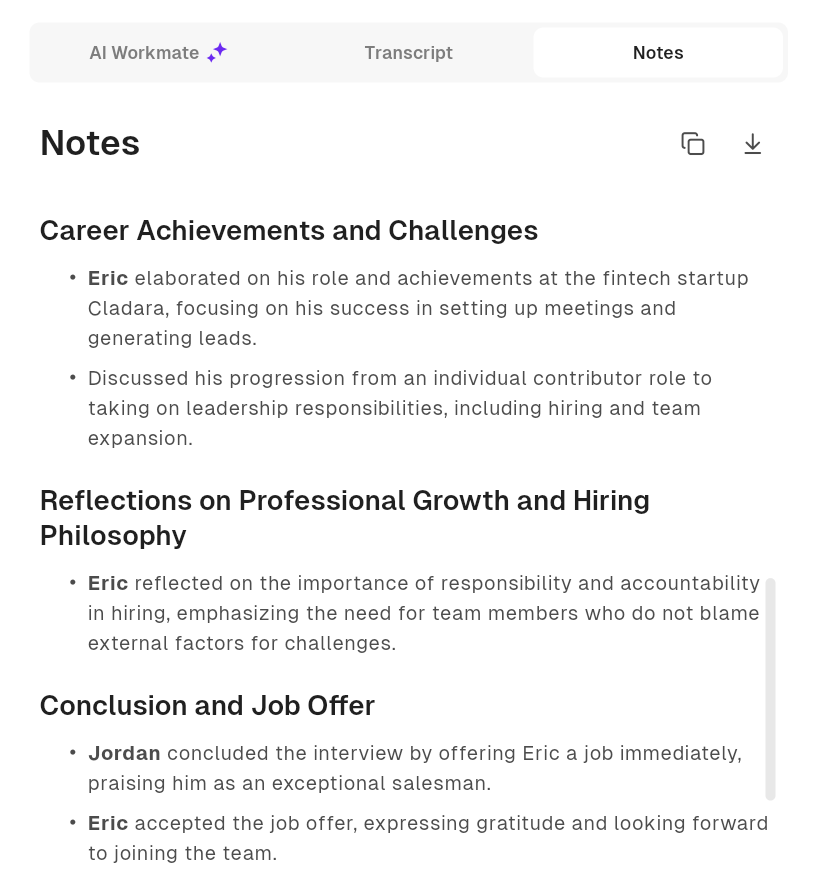
Find out how simple taking notes can be – directly on the platform. Give it a try
For a quick TLDR summary and to create snippets from your transcript, Metaview is a great choice.
It’s set up to help you grab and tweak key points quickly and easily.
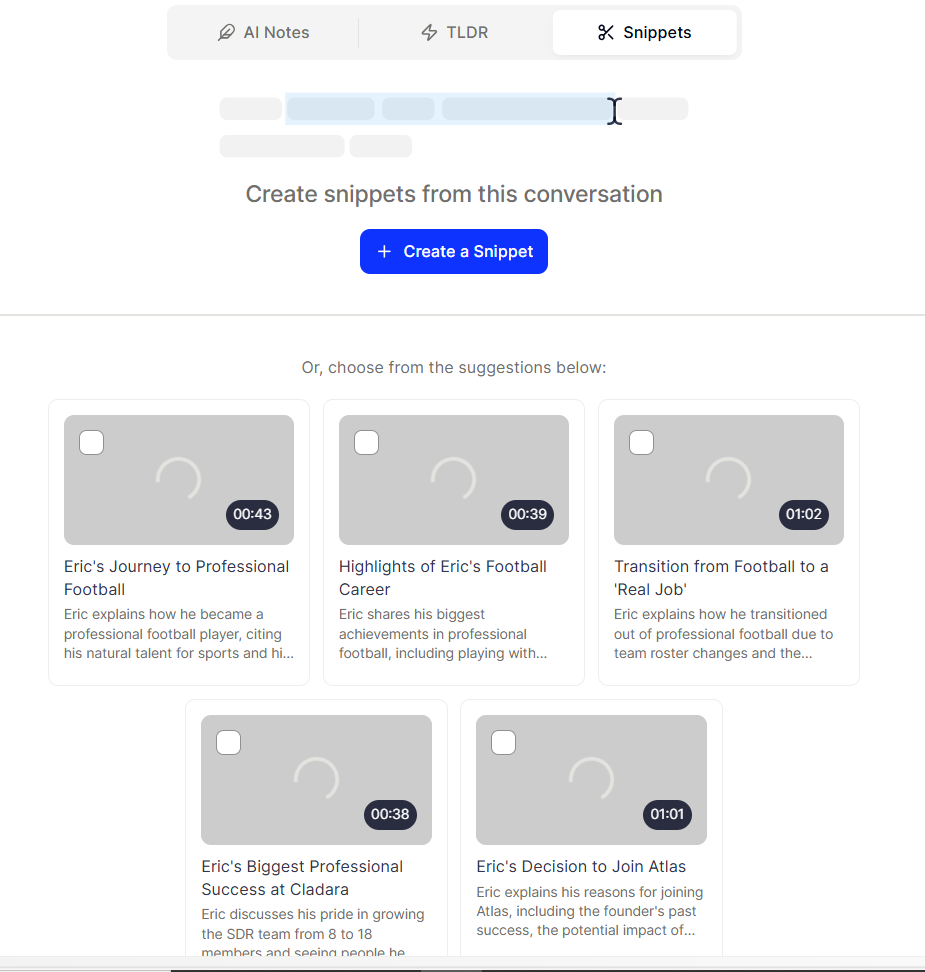
You can also customise your notes by adjusting the length, format, pronouns, and identifiers.
Metaview also has a Template Library where you can pick the format for your notes and summaries from various options like – different types of debriefs, a Q&A format, or an intake template.
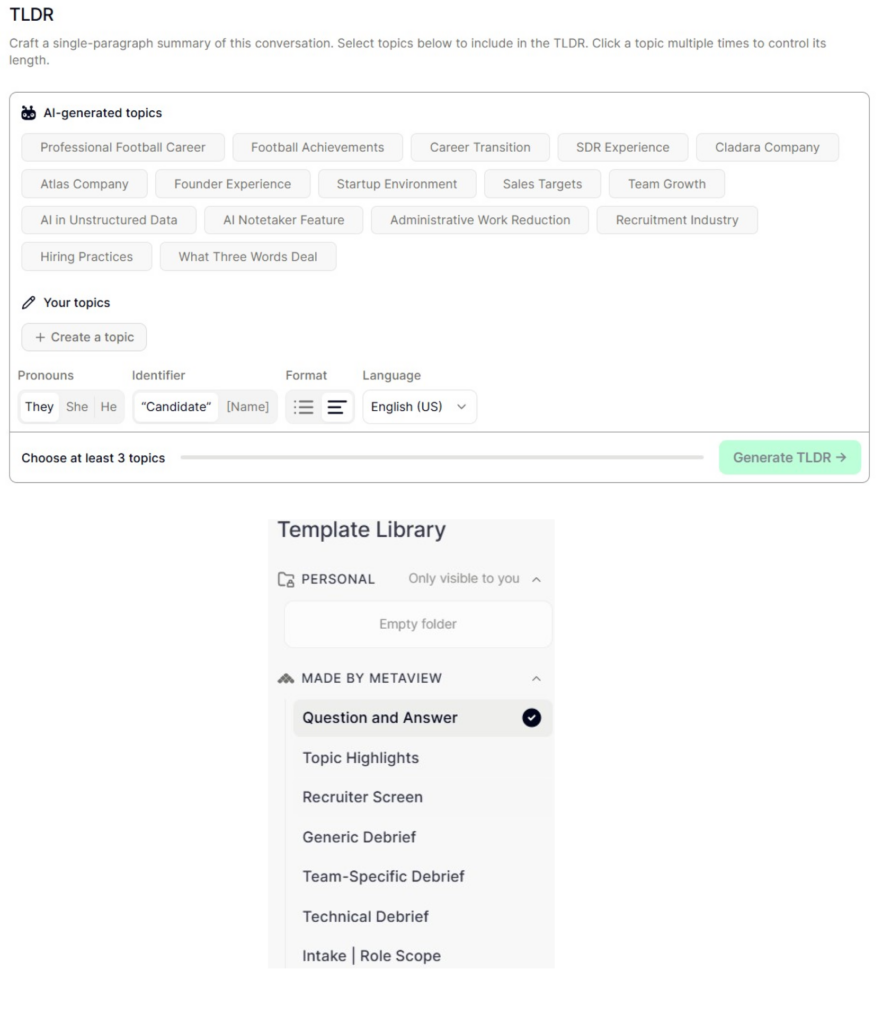
If you need detailed and customisable summaries for different kinds of meetings – like interviews, one-on-ones, or project updates – Fathom is the tool you should check out.
It’s great for creating in-depth and personalised summaries. You can also use the AI prompts to get answers quickly.
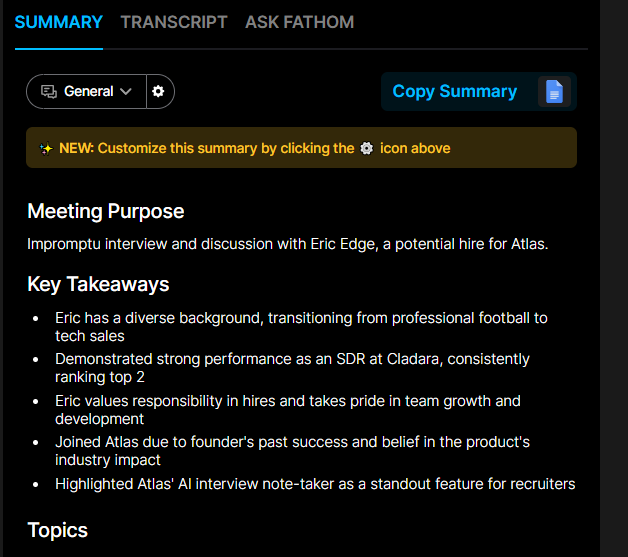
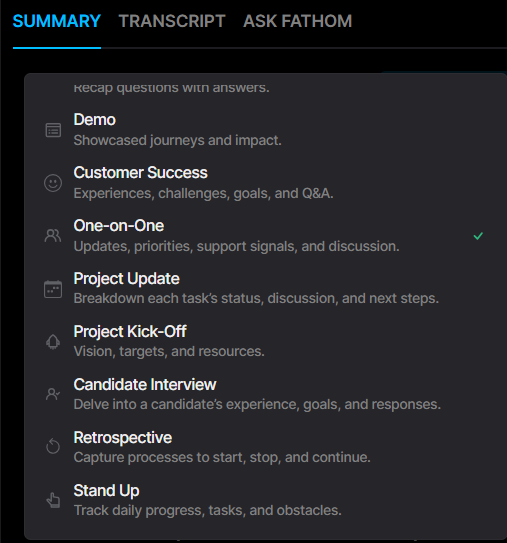
Carv is a great choice if you prefer structured summaries that break down your interviews into actionable sections.
It’s perfect for easily extracting and reviewing key insights.
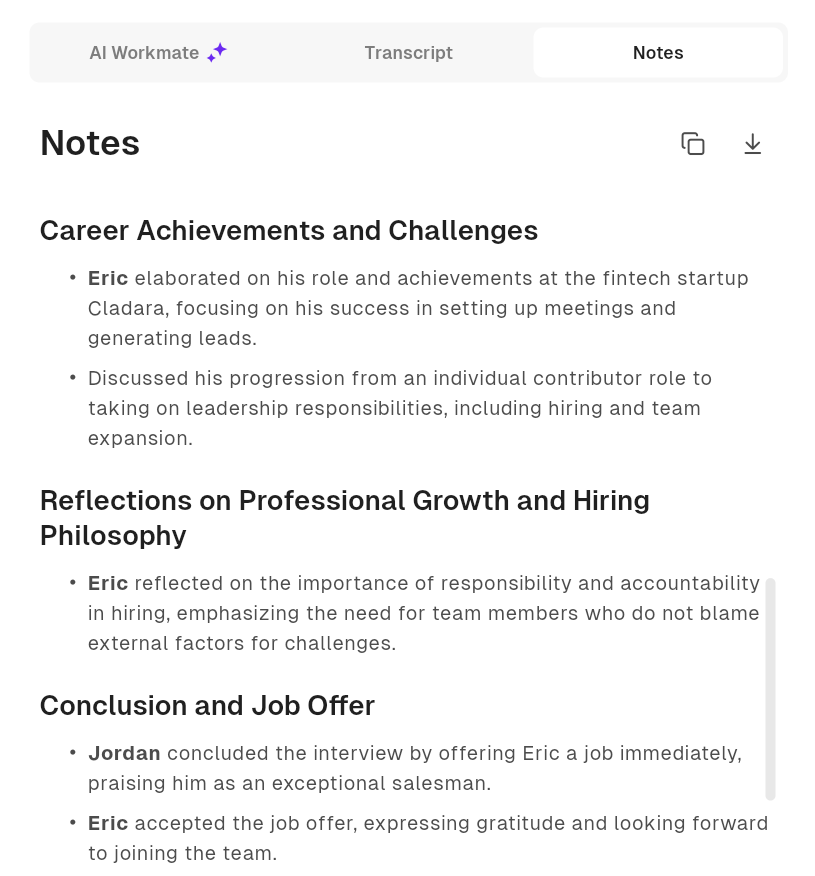
Supernormal works well if you need detailed summaries with timestamps linked to your recording and basic editing features. It’s ideal for referencing specific parts of the conversation and making minor adjustments to your summary, although it can be more focused.
Fireflies produces concise and structured summaries. It is good if you want filtering options where you can analyse metrics, sentiments, speaker talk time – and the ”Smart Search” feature – but these are only available on the Pro plan which costs $10 per seat/month.
Fireflies also features a Soundbite option for capturing key moments from the transcript or based on keywords.
Fireflies produces concise and structured summaries. It is good if you want filtering options where you can analyse metrics, sentiments, speaker talk time – and the ”Smart Search” feature – but these are only available on the Pro plan which costs $10 per seat/month.
Fireflies also features a Soundbite option for capturing key moments from the transcript or based on keywords.

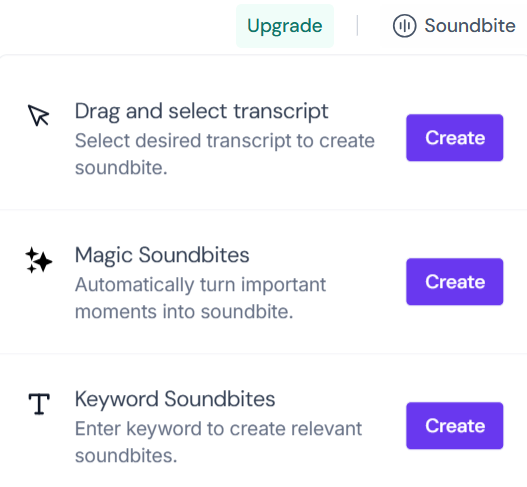
If you need a detailed and structured summaries where you can add actionable tasks,
Krisp gives you the choice between key points or detailed outlines and lets you add action items with features like due dates and team member assignments.
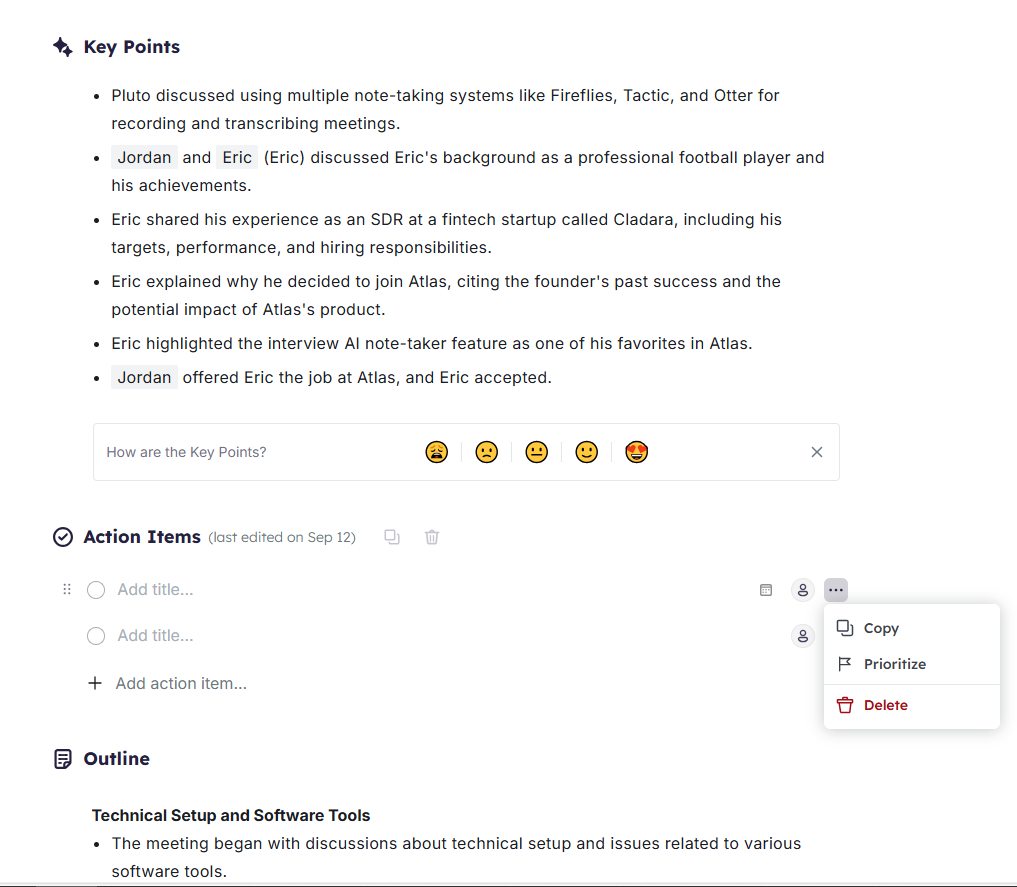
For an organised summary linked to the transcript, Otter is a good fit. Like Krisp, it allows you to add action items, making it more functional when sharing with other team members.
Carv gives you a simple, bulleted summary with minimal customisation options.
If you’re looking for more advanced AI features that offer better summaries and notes, there are other tools that might be a better fit.
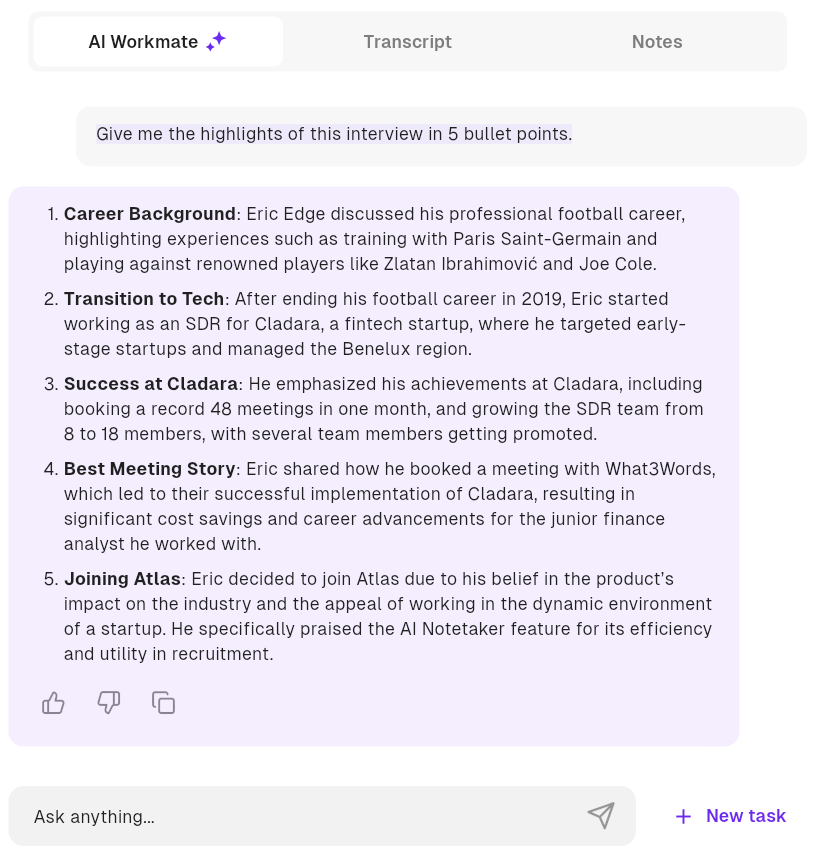
Assessing AI assistants in note taking apps – what works best?
We compared answers to this question we asked all note takers – “What is it about this role that attracted the candidate? Tell me everything the candidate said about it.”
Here’s how different tools answered it:
When you ask Atlas AI a question, it responds quickly.
The answers are detailed, clear, and well organised, with evidence to back them up.
This means you can get useful excerpts from the interview.
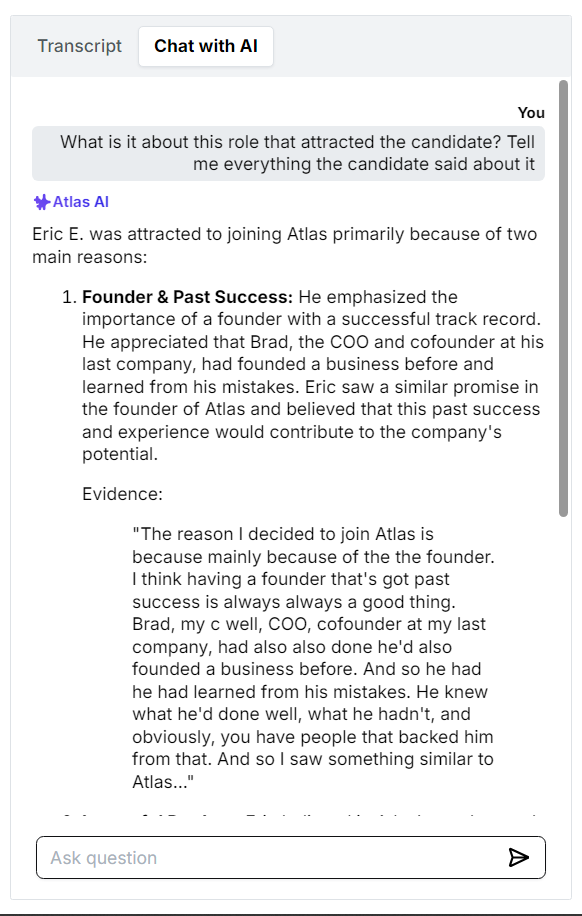
Metaview also gets back to you pretty fast – with brief answers.
It includes a link to the transcript so you can easily see the full context.
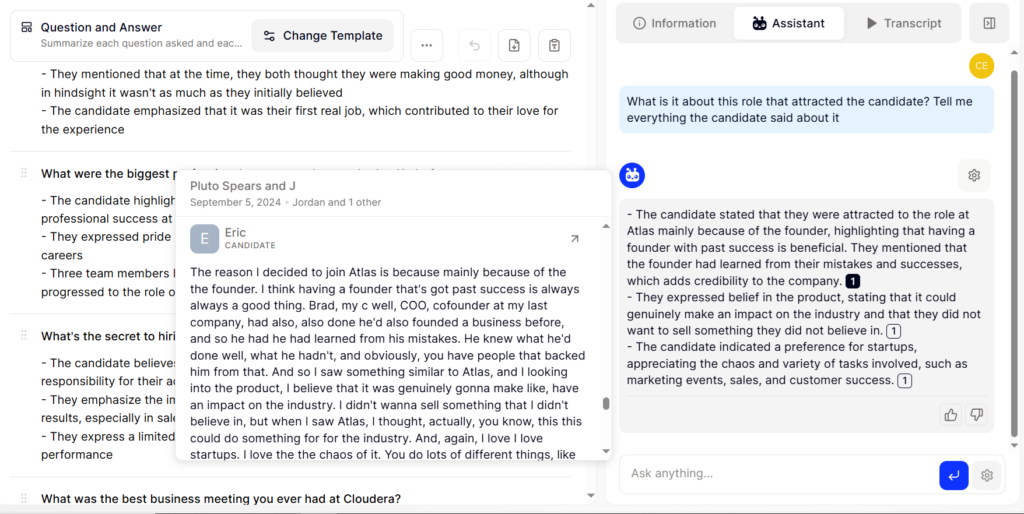
Carv’s “AI Wormate” took the longest to respond, but the response was detailed in a structured format.
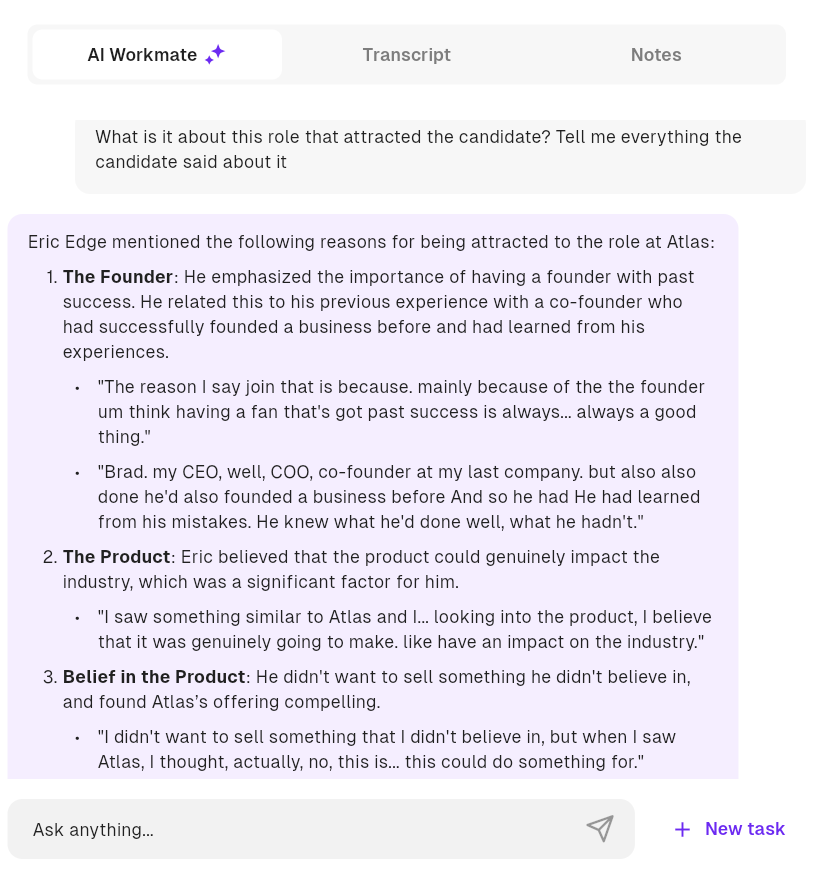
Fathom also responds quickly and provides a detailed, well structured answer.
It has AI prompts and a link to a specific part of the recording, so you can easily listen to a section of your interview.
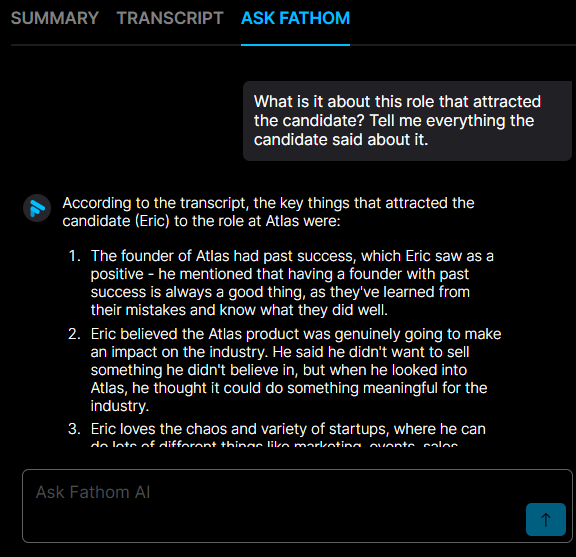

Fireflies’s assistant, “Ask Fred,” takes a bit longer to respond.
It doesn’t include a link to the transcript or recording, but the reply you get is detailed and accurate.
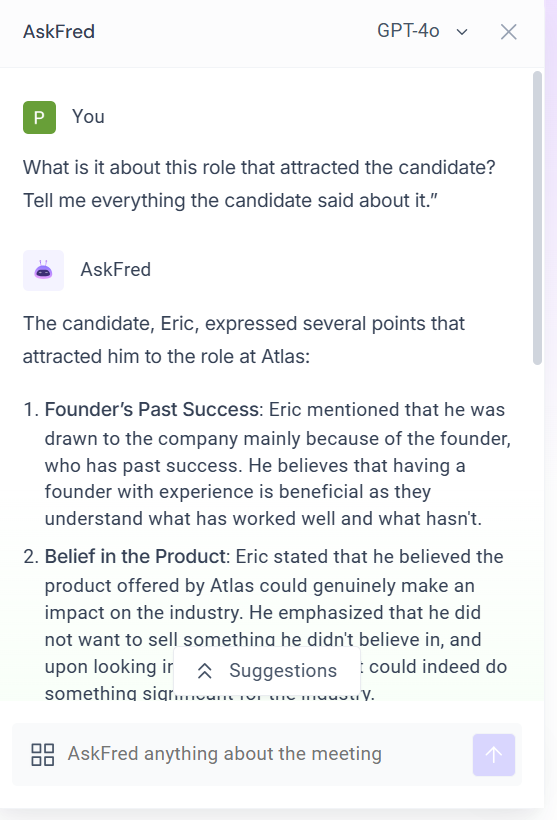
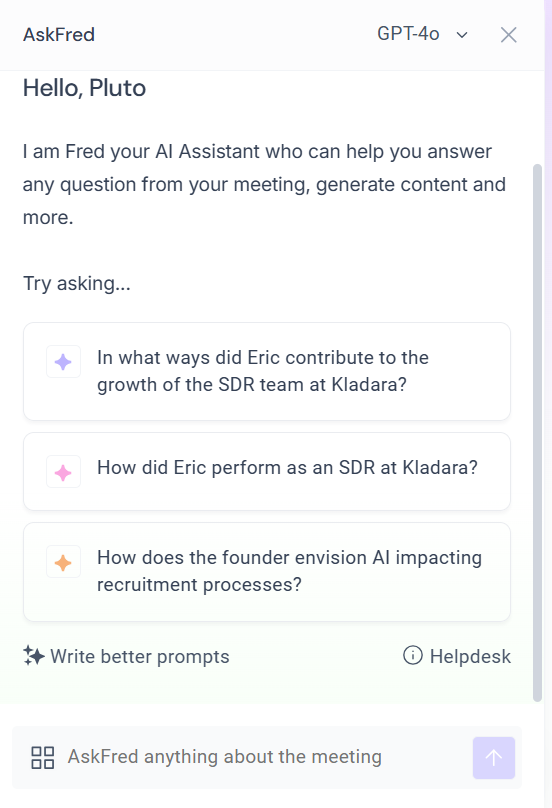
Tactiq replies fairly quickly but the answers are brief and lack depth.
It doesn’t include a link to the transcript or recording, so it can be tough to get more context from the conversation.
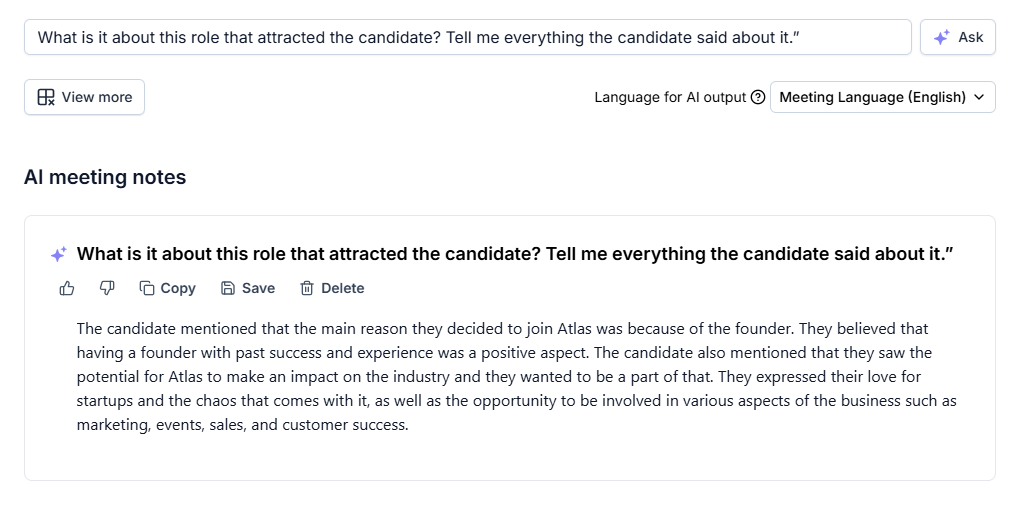
But if you need summaries in specific formats, Tactiq has various quick prompts that can generate short or detailed summaries – with or without citations, bulleted highlights, and action items.

Otter is quick and provides clear, well-organised answers.
It also includes links to the transcript and recording, and offers AI prompts for follow-up questions.
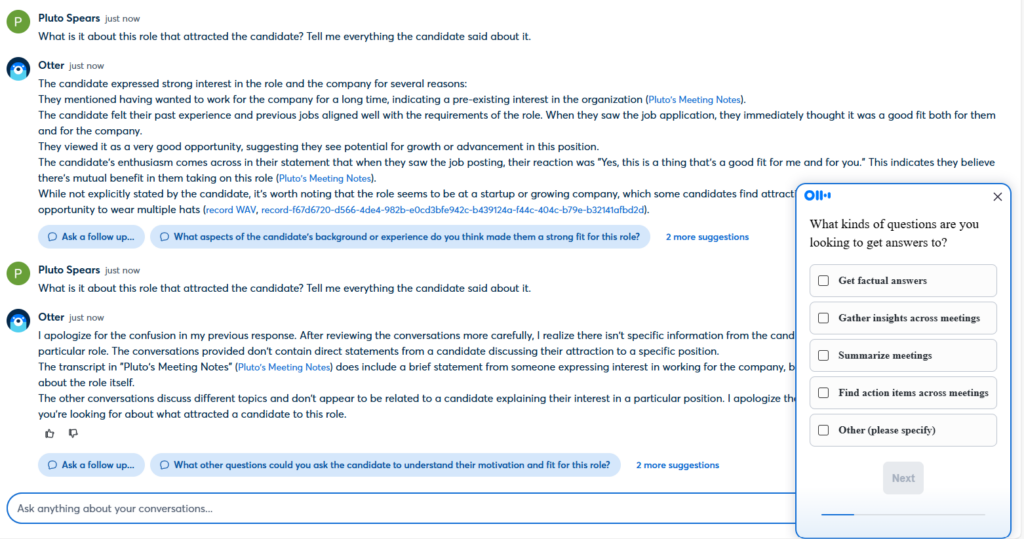
If you’re looking for a note taker with an AI assistant that lets you ask questions, Supernormal and Krisp aren’t the best choices. They just offer basic transcription and summarisation and don’t have AI assistants for asking about the interview.
So, which note taking AI Assistant is the best?
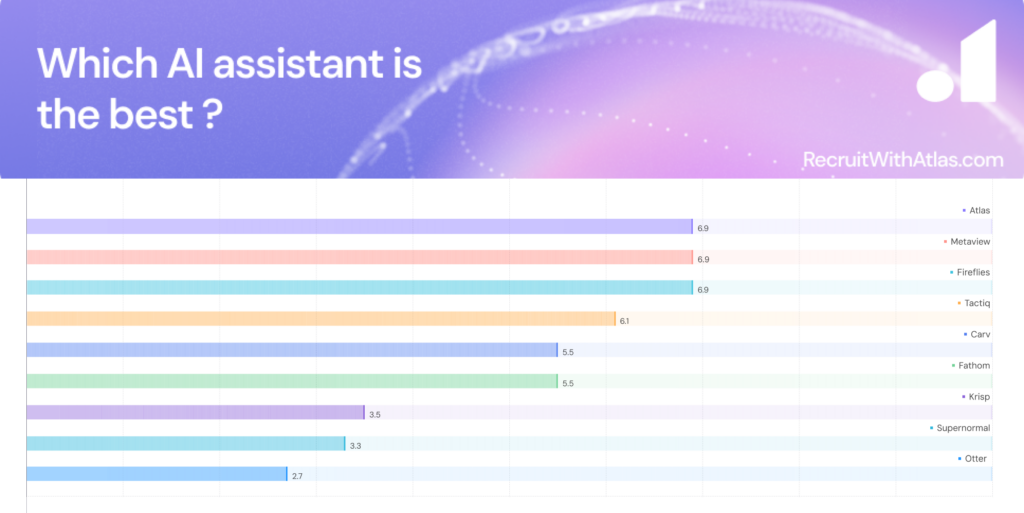
When choosing the best note taking tool that have an AI assistant, it really depends on what you need:
- Atlas delivers fast, detailed, and well-organised responses with evidence to support them, making it great for getting actionable insights from interviews.
- Metaview is ideal for quick TLDR summaries, it has customisation options and links to transcripts, and gives AI prompts.
- Fathom excels at providing detailed and structured summaries with direct links to specific parts of recordings.
- Fireflies provides concise summaries and has filtering options on the Pro plan.
- Tactiq is useful for specific summary formatting needs, but responses lack depth.
- Otter offers well-organised answers with transcript links and AI prompts.
- Supernormal and Krisp offer basic transcription and summarisation features but don’t offer interactive AI features.
- Carv gives you basic summaries and responses with limited customisation. If you need more advanced AI features for better summaries and notes, there are other tools that might be a better fit.
Ultimately, the right tool for you depends on what’s most important – whether it’s the quality of summaries, access to recordings, customisation options, or the ability to manage action items.
How easy is it to use? Comparing UX/UI in note taking apps
When choosing a note-taking tool, the user experience (UX) and user interface (UI) are important because they determine how easily and effectively you can interact with the tool.
A well-designed UX/UI can make a tool intuitive and enjoyable to use, while a poorly designed interface can lead to frustration and inefficiency.
Here’s what we discovered when evaluating these tools:
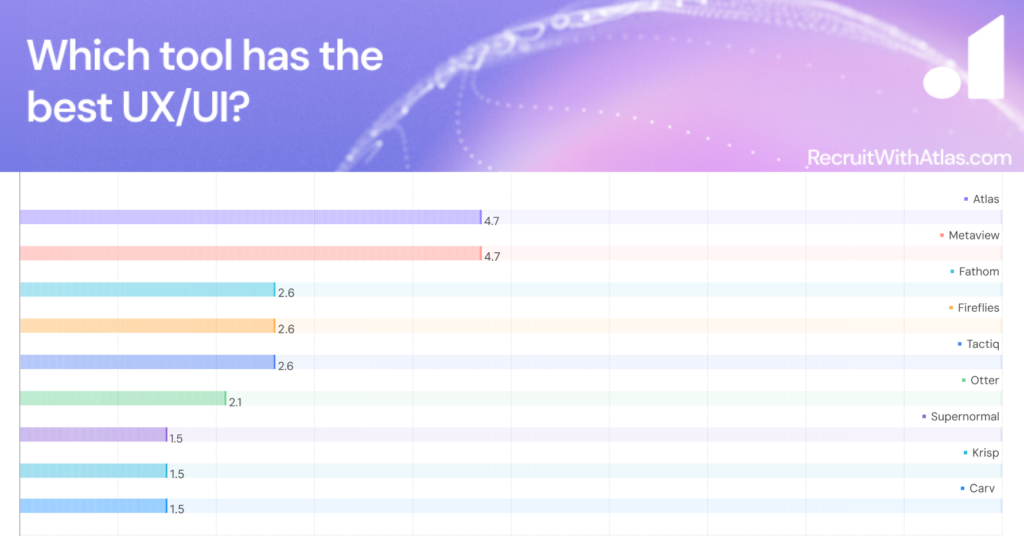
Atlas and Metaview both offer modern, user-friendly interfaces that make them easy to navigate, even for new users. They balance functionality with simplicity, so you won’t feel overwhelmed.
Tactiq packs in a lot of features, but it’s fairly user-friendly thanks to in-app messaging and guidance. However, finding the AI assistant bar can be a bit tricky among all the options.
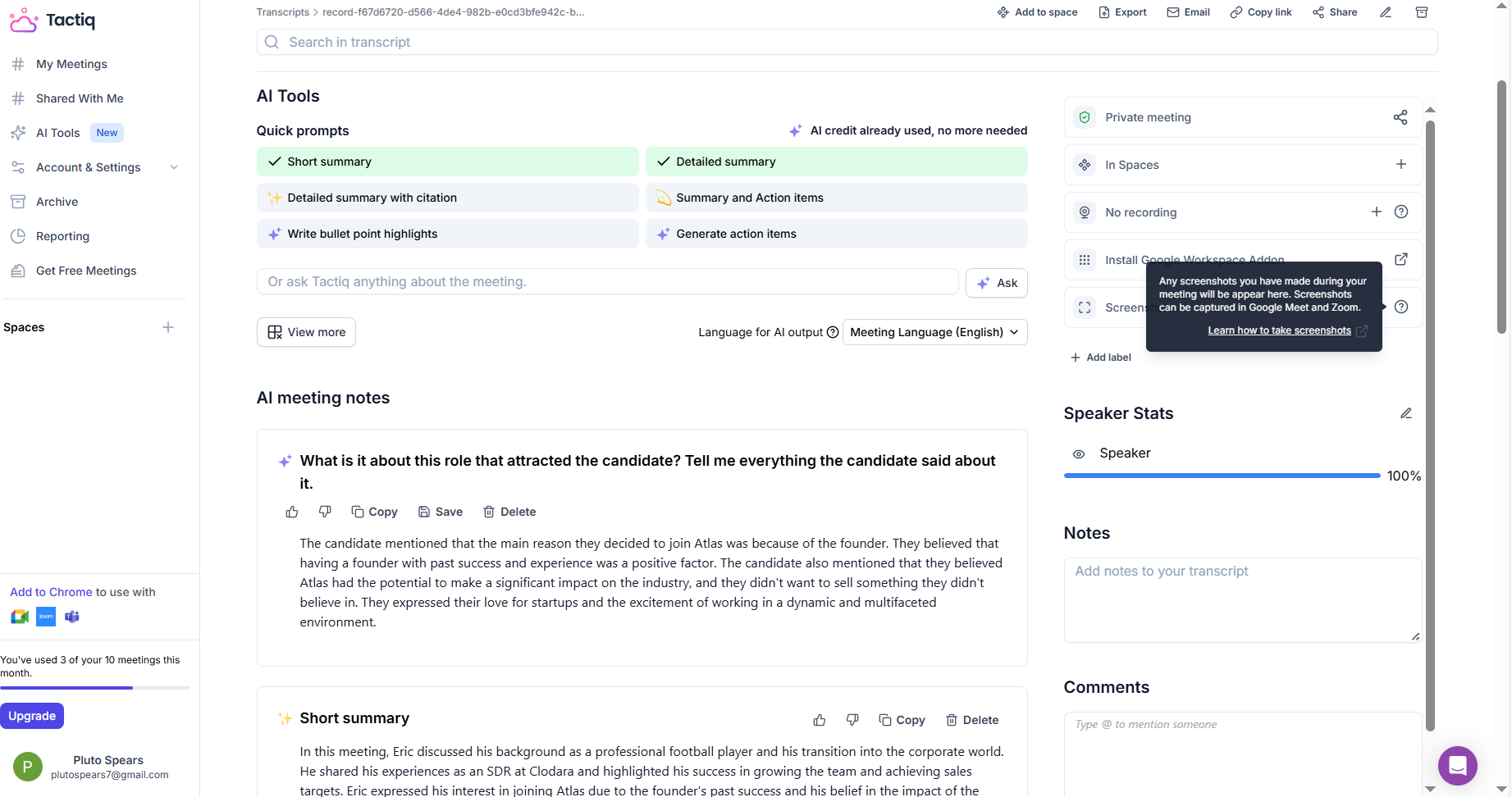
Fireflies has a simple interface, but navigating can be confusing due to screen overlays. It took a bit to locate Fred, the AI assistant, which is a small icon on the top of the left navigation bar.
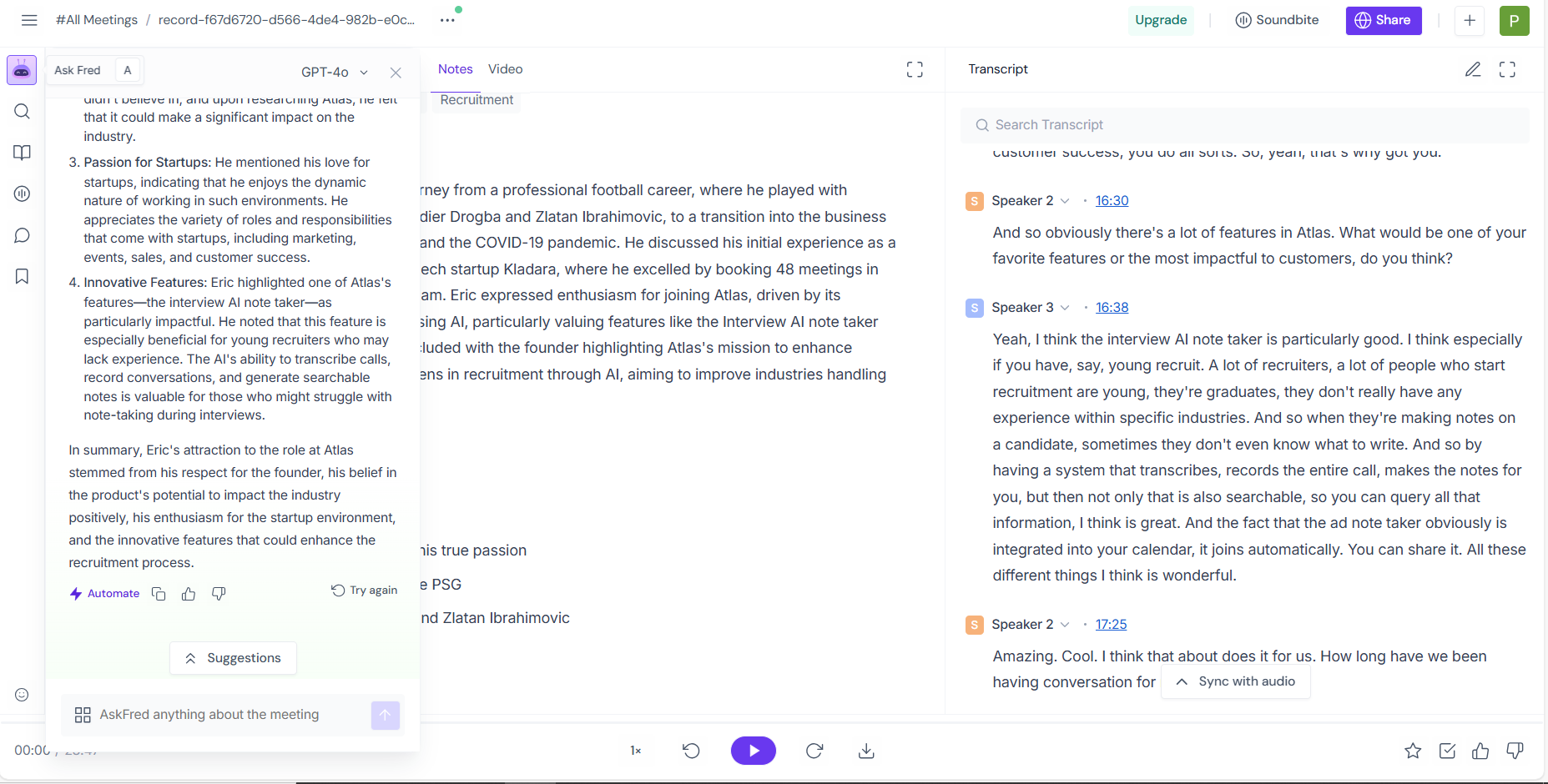
Fathom can feel a bit cramped because of its limited customisation options. The video layout doesn’t leave much room to view summaries, answers, and transcripts. The default Dark Mode might not be to everyone’s liking, and there’s no option to change it.
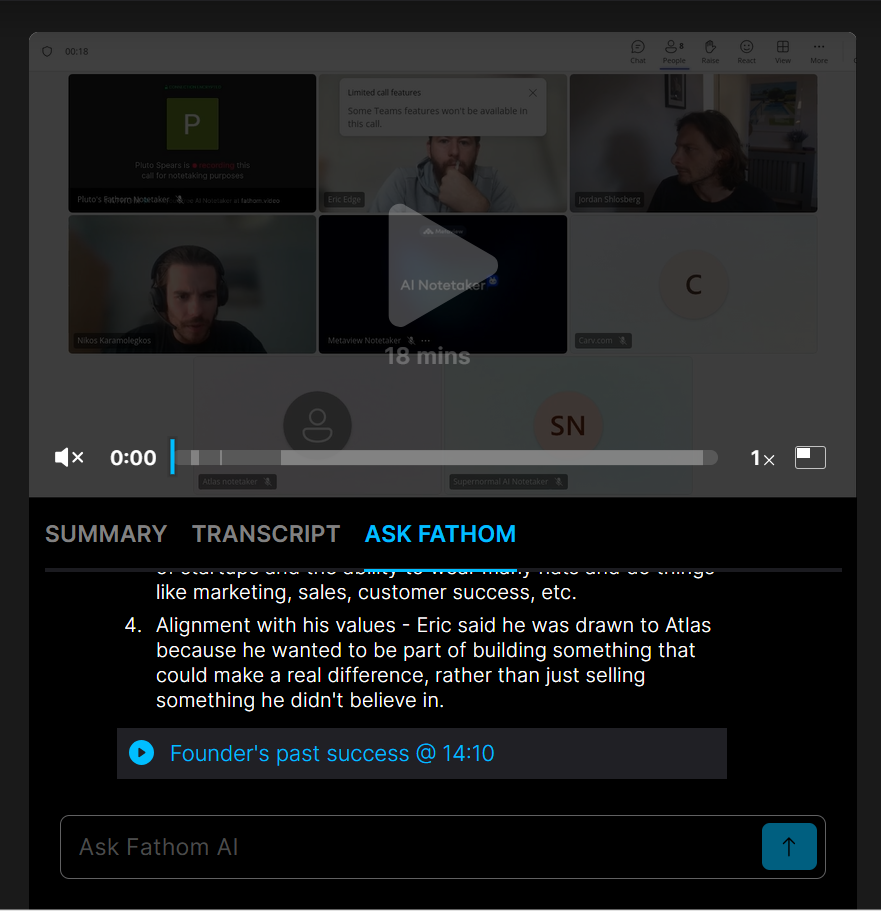
Otter’s main page has a distracting screen overlay, but once you’re into your recordings, the navigation gets easier.
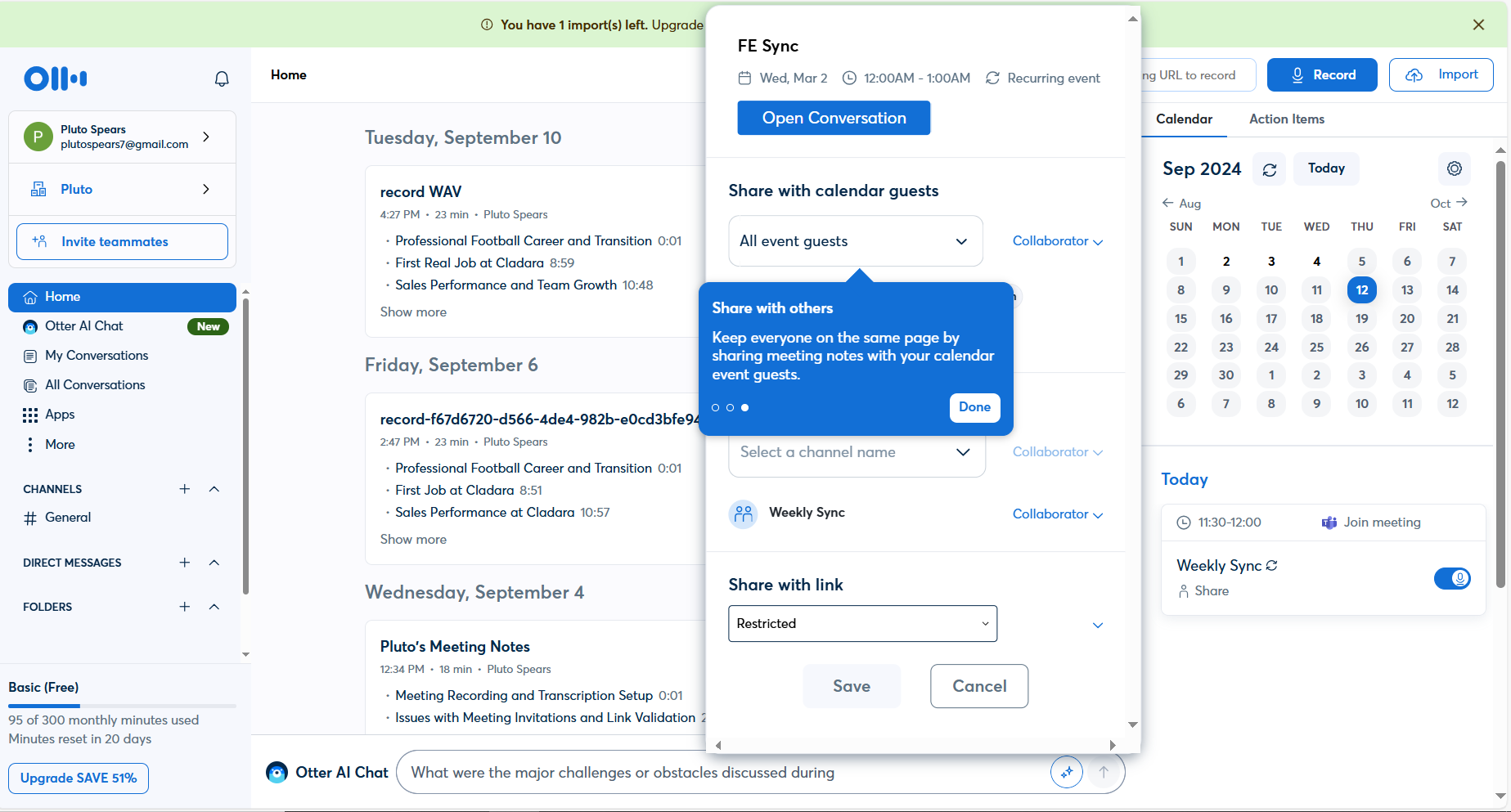
Carv, Krisp, and Supernormal all feature straightforward designs. With their limited features, navigation is quite simple.
Is a new AI note taker really worth the hype?
As a recruiter, especially in executive search, you understand how important taking notes is – it’s not just about jotting down details but about capturing and organising crucial info for client reports.
But as an agency leader, you’re managing a lot more than just notes. Your daily routine involves sourcing candidates, building business relationships, personalising outreach, managing job pipelines, and drafting reports, to name a few.
With so many tasks on your plate, it’s easy to feel overwhelmed, and juggling different tools for each task can add to the stress. What if there was a simpler way?
Imagine an all-in-one recruitment platform where everything you need is in one place – not just your interview notes, but all the info on every candidate too. You can have instant insights based on what everyone in your company knows, making it super easy to find the details you’re looking for.
This way, you can spend less time searching for information and more time focusing on what you do best – find the right executives based on your clients’ needs.
In executive search, efficiency is everything, and the right platform could be just what your business needs to succeed. See how Atlas could become your go-to platform.
Give it a try


